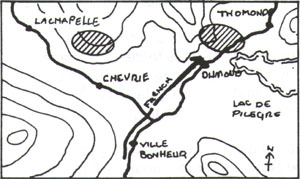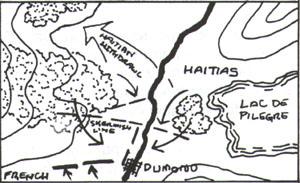This is the first installment of a mini-campaign based on 1805, a fast play two-page rule set written by myself. The subject is Napoleon's attempted reconquest of the island colony later known as Haiti. When peace broke out in Europe it was time to reestablish the home country's authority over its rebellious Caribbean island possessions.
Landing with overwhelming strength on Haiti, French regulars were easily able to secure the coastal cities and surrounding lowlands. However, the insurgent armies of Toussant L'Overature left nothing useful unburned as they retired to the interior uplands.
On 6 December 1804, Gen. Robert Giglio was dispatched on a pacification mission into the Canot Valley some 60 miles north of Port-Au-Prince. He was directed to destroy any supplies the insurgents may have stockpiled in the towns of Saint-Michaelde-Atalaye, Pignon, and Hinche.
The available French forces were:
- 6th Demi-Brigade composed of:
- 14th Fusilere Battalion (Veteran, Steady).
23rd Fusilere Battalion (Veteran, Steady).
9th Leger Battalion (Veteran, Steady).
53rd Voltigeur Battalion (Veteran, Steady)
1st Colonial Demi-Brigade composed of:
- 1 st Battalion Martinique Gendarme (Green Steady).
1 st Battalion, Port-au-Prince Militia (Green, Timid).
2nd Battalion, Port-au-Prince Militia (Green, Timid).
Support units:
- 33rd Foot Artillery Battery, 1 section (Veteran, Timid).
3rd Squadron, 22nd Chasseurs au Chivalle (Veteran, Steady).
To counter this formidable force Toussant entrusted Gen. John Thomas with no less than nine battalions of irregulars and two battalions French trained colonial mutineers.
Pincer Strategy
As the French column snaked northward Gen. Thomas settled on a pincer strategy. Not knowing the enemy's intended route of march, he divided his forces. Six battalions of irregulars were placed in a blocking position over looking the road to Bouchefeau Pass. In a supporting position, 12 miles distant, 2 battalions of regulars and 3 of irregulars lay in wait in the wooded hills near the village of Domond.
 Situation Map
Situation Map
Giglio opted for the easier path along the shores of Lac de Piligre. Although he was accompanied by a squadron of cavalry, he made little use of them until the final stages of the forthcoming action. As the column of march approached a choke point where a ridge spur angled down to the lake shore, Giglio sent 53rd Voltigeurs forward in an extended skirmish line. They were supported by a single battalion of militia. Sending a courier to the support force, Thomas saw an opportunity to drive the French avant garde back into the main body. He launched attacking columns of irregulars against opposite flanks of the approaching skirmishers. On the left, they barely out ran the pursuing mass. On the right flank the light infantry were not as fortunate. Driven back, they were trapped against the still undeployed column of march. A massive melee ensued which found the French at a decisive disadvantage.
The Haitian regulars emerged from the wood, wheeled smartly into line, and began a steady fire into the militia ranks. As their numbers rapidly thinned, the militia morale crumbled and the survivors fled in panic.
 Battle of Dumond
Battle of Dumond
As his center was driven back, and with the vision of a second Cannae staring him in the face, Giglio struggled to deploy his forces. Through extraordinary efforts, first the right and then the left flank battalions wheeled into action.
Expecting his support force to appear any moment, Thomas kept up the pressure. But the Haitians were a spent force. Now it was the French turn to drive back. As they fully deployed, Thomas began a withdraw. He successfully extracting his regulars with little loss. The irregulars were less fortunate. His right flank units melted away in the face French artillery fire. French dragoons hurried off the Haitian right flank with a charge at the end of the action.
Clearly both sides made major errors. The Haitian forces were too greatly separated. While attacking with great audacity from a superior position, they lacked strength in depth and were unable to exploit an initial advantage. Their's was an error of strategy. The French erred in the tactical handling of the engagement. Over extending their skirmish line, they failed to provide it proper support. Inexplicably, cavalry recognizance was not employed. It was only through the initial Haitian strategic failure that the French avoided a disaster.
Next month we will follow the French column as it approaches Haitian positions near the town of Hinche.
Napoleon in the Jungle: Part 2
Back to PW Review February 1997 Table of Contents
Back to PW Review List of Issues
Back to MagWeb Master Magazine List
© Copyright 1997 Wally Simon
This article appears in MagWeb (Magazine Web) on the Internet World Wide Web.
Other military history articles and gaming articles are available at http://www.magweb.com